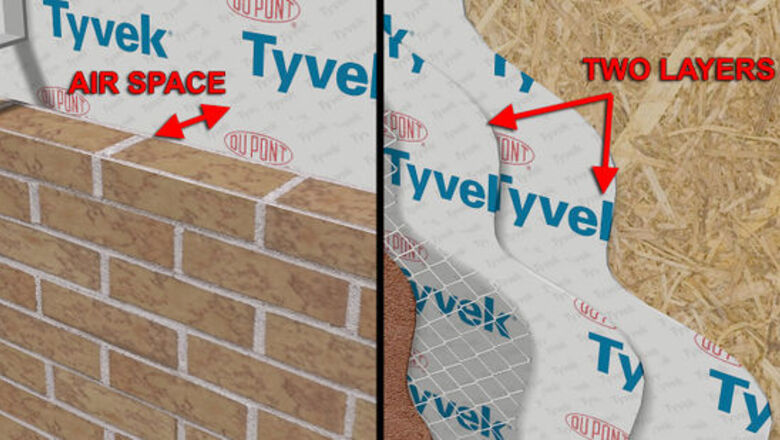
views
Installing Tyvek Over Walls
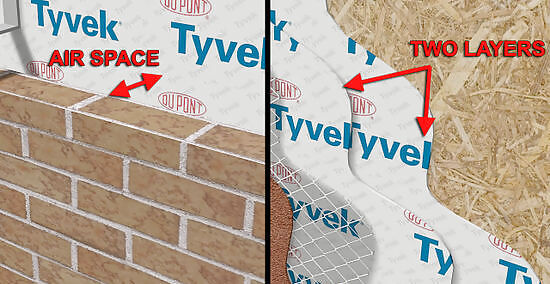
Plan the installation based façade material. Building codes and material manufacturers recommend adjustments when installing Tyvek under certain materials, for maximum air and water barrier effectiveness. Consider these tips if you plan to use these materials over the Tyvek, as they affect your construction plans or the amount of Tyvek you need to buy: Stucco and stone veneer do best with two layers of Tyvek. Brick and foam sheathing should have an air space between it and the Tyvek. Other materials may be installed as usual, although measures that reduce moisture in contact with the Tyvek are always recommended.
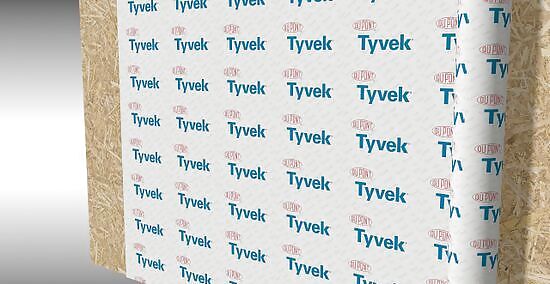
Purchase the correct Tyvek product. Tyvek HomeWrap is suitable for most residential houses. Tyvek ThermaWrap will also help maintain desirable indoor temperatures, while Tyvek DrainWrap includes vertical grooves for increased drainage when high moisture is expected. If you are constructing a commercial building, or a building more than four stories tall, consult an experienced construction expert or DuPont representative for information on more specialized products, such as Tyvek Fluid or high-performance Tyvek. Purchasing Tyvek tape as well is recommended to help seal your wall more effectively, as described below. You may be able to purchase your Tyvek with stud marks printed on the surface at a specified width, which will make it easier to line up with your wall.
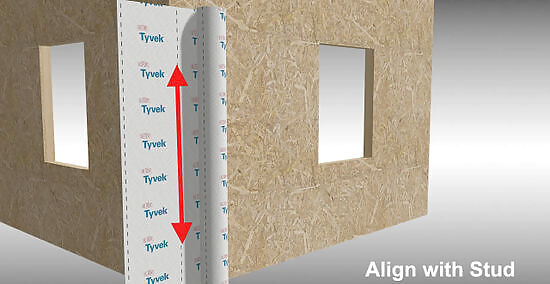
Position the Tyvek. Begin by placing an edge of Tyvek at one end of the wall, leaving a 6–12 inch (15–30 cm) overlap over the corner. If stud marks are printed on your Tyvek product, line them up with the first stud of your wall. The first roll should be plumb with the bottom edge of the wall. If the wall has not yet been raised, let the Tyvek overhang the bottom edge of the wall and fasten it there with Tyvek tape or sealant.
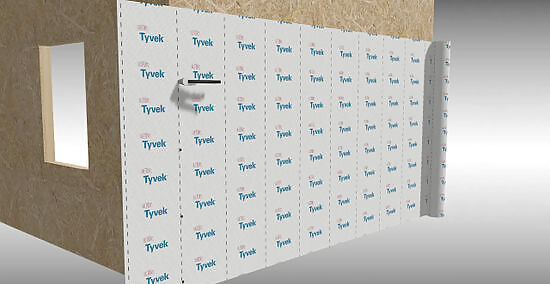
Unroll and attach the Tyvek. Unroll so the Tyvek is taut, but not so much that it gets stretch marks or tears when fastened. Have a second person secure the Tyvek with a fastener every 6–18 inches (15-46 cm), over the wall studs. Choose your fastener depending on the material you are covering: Over masonry, temporarily attach with vertical strips of an adhesive containing polyethylene, elastomeric, or latex, roughly 24 in. (61 cm) apart. Once the whole roll is attached, use cladding fasteners to attach it permanently. Over wood, gypsum board, and most other wall materials, use large head or washer head nails. Unless installing over foam sheathing, you may use staples with at least 1 in. (2.5 cm) crowns.
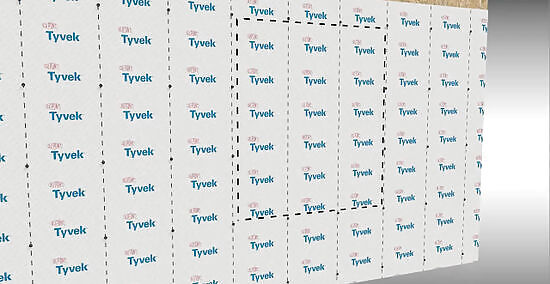
Cover doors and windows. Ideally, install Tyvek before installing the doors, windows, or window flashing. However, no matter what stage of construction these areas have reached, you may cover them completely with the Tyvek while first installing. You will make adjustments to these areas once the wall is covered as described below.
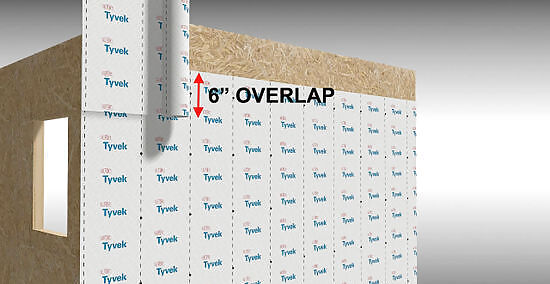
Overlap additional rolls of Tyvek to cover the whole wall. If the wall is higher than the width of the Tyvek roll, unroll additional Tyvek higher than the first, moving upward. Overlap the Tyvek rolls by at least 6 inches (30 cm). Make sure to cover the entire wall surface thoroughly, or air and water protection could be significantly reduced. Use portable scaffolding, not a ladder, when covering Tyvek over high areas. Tyvek rolls are slippery and large, so secure footing is highly recommended when handling them.
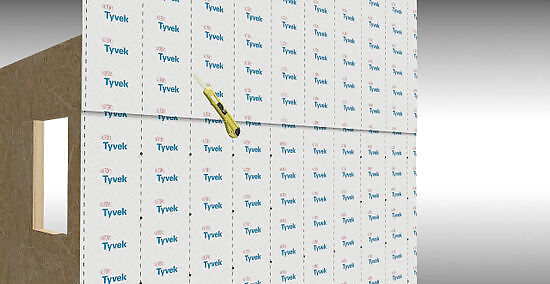
Cut off excess Tyvek. Use a sharp box cutter or utility knife to remove excess Tyvek from around the wall. Make sure to fasten the Tyvek in place at the end of the wall before cutting, including along unusually shaped areas of the wall such as gables.

Cut out windows in an X shape. Cut a large X from one corner diagonally from one corner to the other. Now fold the flaps to the inside and tack them down. If window flashing or a window apron has already been installed, instead cut out the entire outline of the window. Take care not to cut into the flashing itself, if it has been constructed out of a flexible material.
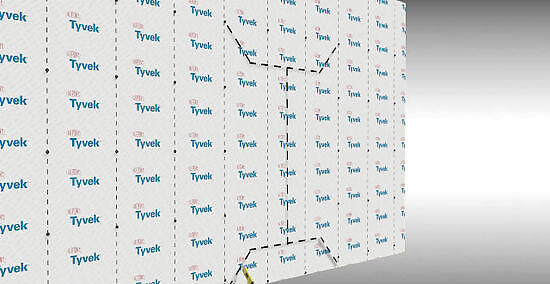
Cut out doors in a capital i shape. Cut an opening for the doors shaped like a capital "i," including the top and bottom horizontal bars of the letter. Cut from the corners of the door openings to each corner of the "I," with the top and bottom of the "I" located approximately 8 inches (20.32 cm) above and below the door opening. Once the cut has been made, fold the Tyvek over the door openings and tack it down on the inside of the framing.
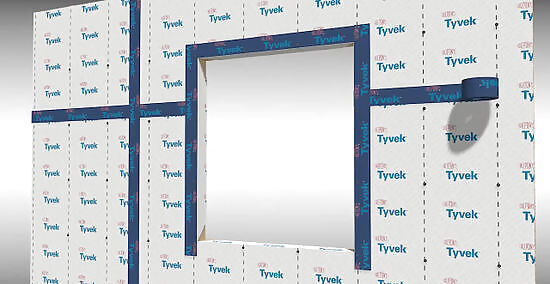
Seal the wall wherever necessary. Use Tyvek tape or a sealant product vetted for Tyvek to cover any areas that require additional protection, forming an airtight seal. Be sure to apply tape or sealant to the following areas: The entire outline window openings except the sill (base). Vertical and horizontal seams where Tyvek rolls overlap. Any tears, puncture marks, or other damage the Tyvek suffered during installation. Larger holes may need a small piece of Tyvek wrap taped over them.
Installing Tyvek Window or Door Flashing
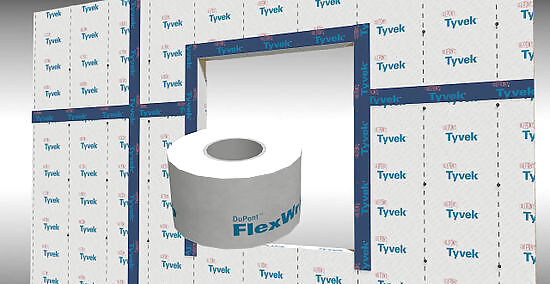
Purchase Tyvek FlexWrap. This is a Tyvek product that can easily be stretched to cover the corners of window and door openings. Choose a width, typically 7–9 inches (18–23 cm) that can easily cover the sill and provide a couple inches (several centimeters) of overlap. While ordinary Tyvek wrap is typically cheaper, it will not provide as durable and effective a water barrier for window sills.
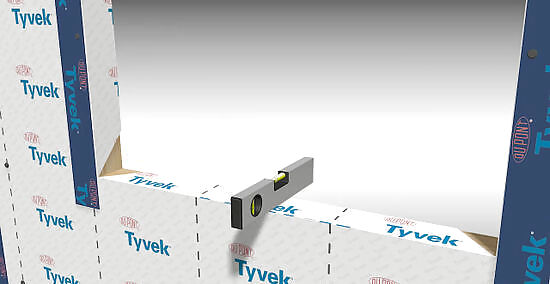
Check the slope. The windowsill should be level or sloped slightly outward, to provide adequate drainage. If it is sloped inward or sloped severely in either direction, install a sloped sill pan before continuing.
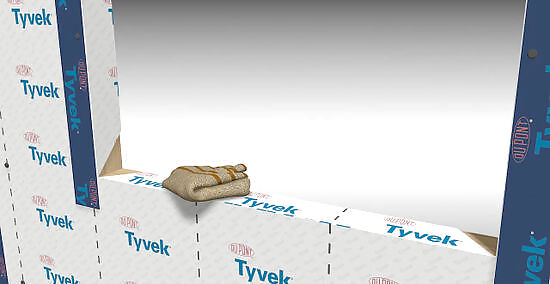
Clean the sill. Wipe the sill and surrounding surfaces with a dry cloth to remove all moisture, grease, dust, and frost from the area.
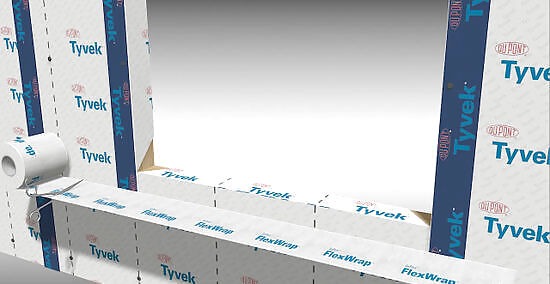
Cut the FlexWrap. Cut the FlexWrap at least 12 in. (30 cm) longer than the sill surface. This extra space ensures the entire sill will still be covered once the Tyvek FlexWrap is stretched around it and fastened.
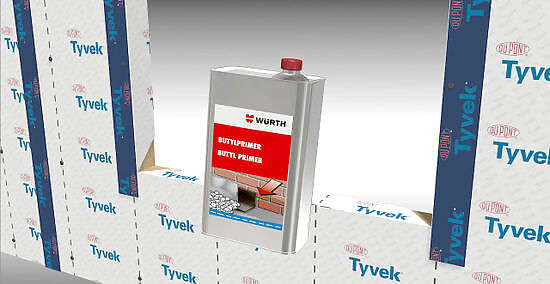
Apply primer in certain conditions. Primer is only necessary in areas of severe weather conditions, severe cold temperatures, or certain building materials. Apply primer if the sill is made from concrete, masonry, or fiber-faced exterior gypsum board. DuPont, the manufacturer of Tyvek, recommends using a DuPont-approved primer for this purpose, such as the following: SIA 655 or Perma-grip 105 (Henkel) Hi-Strength 90 (made by 3M) Butyl Primer (Denso)
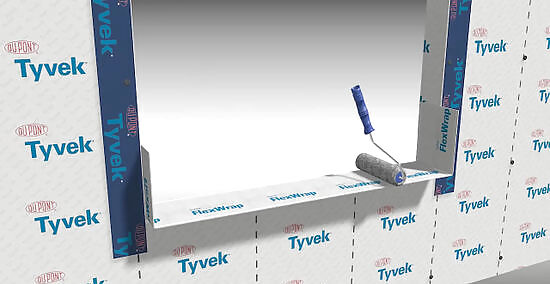
Lay out the FlexWrap. Place the Tyvek FlexWrap over the sill, so it completely covers the base and hangs over the surrounding vertical sides. Do not stretch the Tyvek while laying it across the sill. Smooth it out with your hand or a roller to make it flat and even.
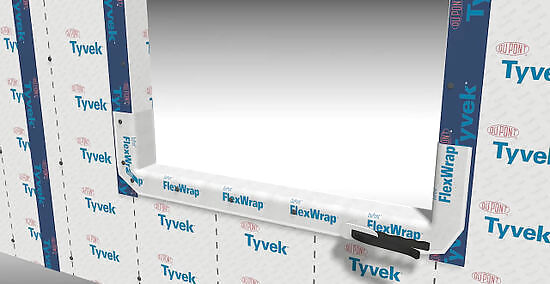
Stretch and fasten the FlexWrap over the corners. Hold the FlexWrap in place over the sill, then pull one corner to stretch it onto the surrounding wall surface. Use a staple, washer head nail, or other fastener to attach the FlexWrap over the wall. Repeat for the remaining corners.
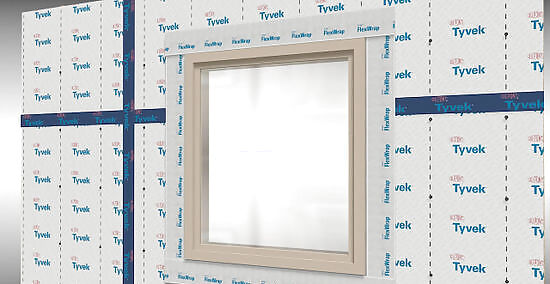
Make adjustments while install the window or door. Follow the window or door manufacturer's instructions for installation. However, make sure not to caulk the FlexWrap base of the sill. After installation, you can provide additional protection by installing FlexWrap strips over the exterior jambs (sides), then cover them with a strip over the head (top) of the window.
















Comments
0 comment